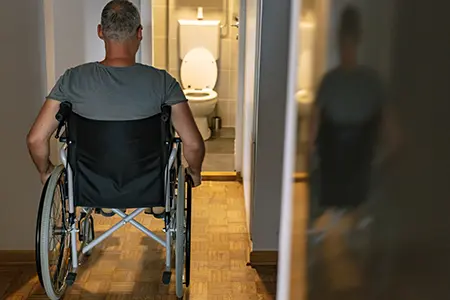Home Modifications for Aging in Place
Our home modification services are designed to transform your living space into a haven of accessibility and convenience. We understand that as time goes on, certain modifications become essential to ensure your safety and comfort. Our experienced team collaborates closely with you to identify your specific requirements and create customized solutions that seamlessly integrate with your home and needs.
Home accessibility modifications are changes made to living spaces to accommodate individuals with disabilities or mobility challenges, enabling them to move around and perform daily activities with greater ease and independence. These modifications can range from minor adjustments to major renovations.

Improve Your Home’s Functionality and Safety
What makes Forever Active unique is our personalized approach to care. We conduct a comprehensive home assessment to identify the specific medical equipment and home accessibility needs. By thoroughly evaluating the environment, we can pinpoint potential barriers and suggest appropriate modifications. These assessments are vital in ensuring that clients can navigate their homes safely and independently.
Here are some examples of home accessibility modifications:
Ramps and Lifts:
- Installing ramps at entrances to replace or supplement stairs, providing wheelchair or walker access.
- Adding stair lifts or platform lifts for multi-story homes, allowing individuals to navigate stairs safely.
Widened Doorways:
- Widening doorways to accommodate wheelchairs or other mobility devices.
- Removing or replacing doors with sliding or pocket doors for easier access.
Grab Bars and Handrails:
- Installing grab bars in bathrooms, showers, and near toilets to assist with stability and balance.
- Adding handrails along hallways, staircases, and ramps to provide support while moving around.
Bathroom Modifications:
- Creating roll-in showers with zero-threshold entries to eliminate tripping hazards.
- Installing raised toilet seats or wall-mounted toilets for easier transfers.
- Adding non-slip flooring and shower benches for increased safety.
Kitchen Adaptations:
- Lowering countertops to wheelchair height or providing adjustable surfaces.
- Installing pull-out shelves and drawers for easier access to kitchen items.
- Lever-style faucets and loop handles for faucets and cabinets that are easier to operate.
Flooring and Pathways:
- Using non-slip flooring materials throughout the home to reduce the risk of falls.
- Ensuring clear pathways and minimizing clutter to allow for easy movement.
Lighting and Controls:
- Installing motion-sensor lighting to automatically illuminate spaces when someone enters.
- Using rocker-style light switches and touch-sensitive controls that are easier to operate.
Bedroom Modifications:
- Adjusting bed heights to facilitate transfers and positioning.
- Installing adjustable or hospital-style beds for personalized comfort and support.
Home Automation:
- Implementing smart home technology to control lights, thermostats, and other devices remotely or through voice commands.
Accessible Entryways:
- Creating zero-step entryways with flat surfaces to accommodate mobility aids.
- Adding peepholes at various heights to accommodate different eye levels.
Visual and Auditory Aids:
- Installing visual doorbell alerts and intercom systems for individuals with hearing impairments.
- Incorporating visual fire alarms and smoke detectors for those who are deaf or hard of hearing.
Lever Door Handles:
- Replacing traditional round doorknobs with lever-style handles that are easier to operate, especially for individuals with limited hand strength.
Outdoor Modifications:
- Creating accessible outdoor spaces with level pathways, seating areas, and gardens.
- Installing handrails and support bars along outdoor steps and ramps.
These examples showcase the wide range of modifications that can be made to homes to enhance accessibility for individuals with disabilities or mobility challenges. The specific modifications needed will vary based on the individual's needs and the layout of the home. Consulting with professionals experienced in accessible design, like our team, can help ensure that modifications are tailored to your requirements.
Our Expertise at Your Service
Forever Active’s goal is to help people successfully remain in their homes by creating accessible, barrier-free environments. Why choose us for your home modification? A few reasons include:
- We work alongside licensed general contractors to make sure all the work we do is done with professionalism and up to industry standards.
- We only employ Certified Aging-In-Place Specialists (CAPS) to do home assessments.
- Our staff is committed to ensuring that all work meets ADA (Americans with Disabilities) and RESNA (Rehabilitation Engineering Society of North America) standards.
- We're certified by IDEAS (Innovative Designs in Environments for an Aging Society), CEAC (Certified Environmental Access Consultants), and Fall Prevention Center of Excellence.
Our Process: How It Works
- Assessing Accessibility Needs: Conduct thorough evaluations of individuals' homes to determine their accessibility needs. This includes inspecting the layout, design, and physical features of the home.
- Client Consultation: Meet with clients to understand their specific mobility challenges, disabilities, and goals for home accessibility modifications. Discuss their requirements, preferences, and any specific concerns they may have.
- Conducting Site Surveys: Conduct detailed site surveys to identify areas of the home that need modification or improvement to enhance accessibility. This may involve measuring doorways, assessing ramps and staircases, evaluating bathroom and kitchen accessibility, and examining flooring and lighting.
- Identifying Solutions: Analyze the collected data from the site surveys and client consultations to identify appropriate accessibility modifications. Recommend suitable modifications, adaptive equipment, assistive technologies, or design changes to improve accessibility and ensure safety.
- Researching Building Codes and Standards: Stay up to date with relevant building codes, accessibility standards, and regulations to ensure compliance with local, state, and federal guidelines when recommending modifications. Familiarize all with ADA (Americans with Disabilities Act) guidelines and other relevant accessibility standards.
- Collaboration with Other Design Professionals: Collaborate with architects, interior designers, and other professionals involved in the home modification process. Provide them with detailed specifications and instructions for implementing the recommended modifications.
- Cost Estimation: Prepare cost estimates for the recommended modifications, considering the materials, labor, and any additional expenses involved. Provide clients with accurate estimates and guidance on potential funding sources or financial assistance programs available.
- Documentation: Maintain accurate records of evaluations, site surveys, recommendations, and cost estimates. Prepare comprehensive reports summarizing the evaluation findings and proposed modifications.
- Client Education: Educate clients about the benefits and implications of the recommended accessibility modifications. Provide guidance on how to operate and maintain the modified features or equipment effectively.
Contact us today to learn more about how we can help you age in place safely and comfortably.
Get the Most Out of Your Insurance
We understand that you will be thinking about your budget when it comes to home modifications. That’s why we work with your insurance company to get the most out of your coverage. We'll help you file the necessary paperwork and get the approvals you need. Check out which insurances we accept today.
